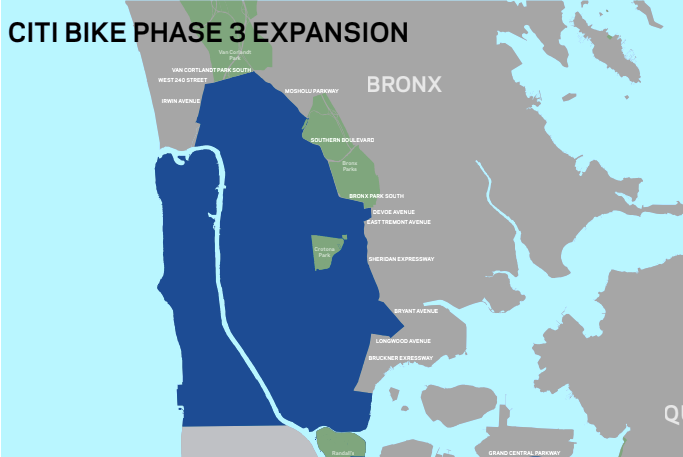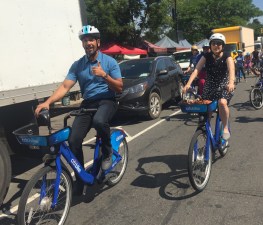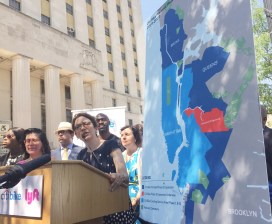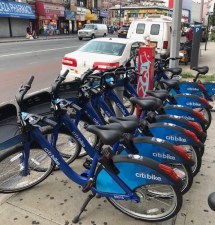Op-Ed: Citi Bike Expansion Leaves Out Crucial Chunks of the Bronx
The borough's dockless-bike pilot will evaporate, and its transit deserts remain starved. We know who rates with City (or should we say Citi?) Hall.

Citi Bike’s recent announcement that it would expand into the Bronx by 2023 is eliciting the famous Bronx cheer among many local bike activists.
Maybe we should be grateful that, six years after bike share’s official city launch, Citi Bike and Mayor de Blasio finally want to make us a part of the network. But a look at the fine print shows the expansion is too little, too late.
True, the close-to-Manhattan neighborhoods of Mott Haven, Melrose, Port Morris, Highbridge, Claremont, Morrisania, Longwood, Concourse, and Mount Eden will get bikes, as will the further-out neighborhoods of Bedford Park, Fordham, and Kingsbridge Heights (although, curiously, the last three were not named in the announcement).
But the entire East Bronx — important areas such as Soundview, East Tremont and Coop City — as well as Hunts Point in the South Bronx and neighborhoods along the borough’s western and northern edges, including Kingsbridge and Wakefield, will miss out.
Further, the Fordham neighborhood in the north-central Bronx actually will lose its bike-share system for the four years until Citi Bike arrives. The dockless-bike pilot that Citi Bike and Jump brought to the neighborhood in 2018 ends this summer, according to reporting in The City. The Department of Transportation confirmed that the free-standing bikes will be gone by Labor Day.

The list of neighborhoods chosen for the expansion also demonstrates that the city is making the same mistake that the Bloomberg administration did when Citi Bike launched in 2013, by bringing bikes only to the most transit-dense neighborhoods — while leaving out vast transit deserts, the very places that would benefit the most from the expansion. Here, bike share could transform lives as a “last mile” solution to help people get to trains, shortening some of the longest commutes in the city — and, not incidentally, keeping cars off the Bronx’s dangerous roads.
But where Citi Bike expands is not completely de Blasio’s call. For some reason (misplaced priorities?) the mayor refuses to subsidize Citi Bike — a public-private partnership with Lyft — so the city can’t dictate where Lyft spends money on the expansion.
What a missed opportunity! DOT Commissioner Polly Trottenberg said the cost of rolling out Citi Bike to all five boroughs would amount to a scant $500 million. That’s less than the $600 million the mayor has spent on the NYC Ferry system, which carries only 30,000 passengers on good days, a fraction of Citi Bike’s 80,000 daily trips.
And de Blasio feels just fine about ceding that responsibility. “I stand very comfortably by the notion that certainly up to now not subsidizing it has still allowed us to get the result we needed,” de Blasio said in response to a question from Streetsblog.
Really? When the Bronx — 1.5 million people — isn’t going to become integrated into bike share for fully 10 years after the program’s start?
But, be that as it may, we go to ride with the mayor we have, not the mayor we want. Moving forward, what would Bronxites like to see for bike share in our borough?

First, the entire Bronx must be served — and DOT should prioritize the transit deserts, which would help cut back on car trips. According to the city’s annual mobility survey, the Bronx had the highest percentage of people connecting to or from transit by car, 4 percent, almost twice the city average of 2.2 percent. A case in point: The Metropolitan Transportation Authority is building new Metro North Stations at Co-op City and three other locations. From the northern end of Coop City, a huge complex, it’s a 30-minute walk to where the train station will be. By bike, that same trip becomes 10 minutes. Similarly, the NYC Ferry in Soundview is a shlep without a car, and lack of parking has been an issue. Bike share could replace many of these car trips.
Second, the Bronx should not have to wait until 2023 rolls around to get its share of bikes. DOT says it needs to conduct extensive outreach before bikes can be rolled out — that is, it needs to make nice with anti-bike, pro-car community boards, of which the Bronx has many. But the boards are not required to provide input on where to place docks.
DOT knows what works already. So plop down the docks and — in the unlikely situation that problems arise — they can easily be moved later.
Moreover, until the docked system can reach the entire Bronx, dockless bikes should be made available in all areas.
Bronx cycling activists want to know: Has the city considered contracting with any companies for dockless bikes for areas outside the Citi Bike expansion plan? Did it agree to provide Citi Bike with a monopoly, even for areas Citi Bike doesn’t plan to serve? If so, why?
Streetsblog reached out to DOT on those questions. DOT responded that Citi Bike has “exclusivity” in “phase 3 areas” — meaning the colored areas on its map showing the expansion — but “not beyond.” It declined to answer whether it has considered contracting for free-standing bikes outside the Citi Bike zone.
Fordham’s dockless Jump bikes were a successful pilot. Each of the bikes there averaged a hefty five rides a day only a few months into the program. In fact, I often see them in my neighborhood a couple of miles south of their service area. They should be restored.
Third, in order to make “last mile” bike commuting feasible for more riders, the cost of a Citi Bike ride should be pegged to the cost of a Metrocard swipe with an integrated fare-payment system, providing free transfers to subways and buses. Any additional subsidy would more than pay for itself by reducing costs associated with congestion, traffic injuries, emissions-related illness, and sedentary lifestyles.
We in the Bronx appreciate that a bike-share discount program exists for people who live in NYCHA communities or receive food stamps. But let’s face it: Bike share won’t truly become integrated — in all senses of the word — without free transfers.
Finally, construction of a protected, continuous bike-lane network throughout the Bronx must begin immediately. For far too long, the city has failed to invest equitably in our borough, as a glance at the DOT’s current bicycle routes projects shows. The Bronx has four projects under way, as compared to nine in Brooklyn and 12 in Manhattan! It is clear who rates with City Hall.
To borrow a phrase from Bronx Council Member Ritchie Torres, this is “the transportation equivalent of redlining,” and it must end.
Get to it, DOT.
John Halpin is a cycling activist in the Bronx. He lives in the Concourse neighborhood. He’s on Twitter as Bronxitenyc.



